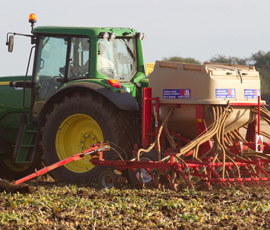Certified seed ‘may be later than normal ‘

This autumn is likely to see a realignment of rotations, variety choice and sowing dates as arable farmers strive to get cropping back on to an even keel following the challenges of the past two seasons, predicts Openfield technical manager David Leaper.
He says those who were forced to sow whatever seed – at whatever timing – they could, just to get a crop established, will be looking to drill early this autumn to resurrect their normal production cycles.
“I anticipate that the demand for certified seed will be high this year, because people will want to get back to growing their varieties of choice after having had to settle for what they could last year.”
But he advises farmers to remain flexible about how, when and what they sow, because their options will hinge heavily on the growing conditions for their own and the country’s seed crops between now and harvest.
“It is likely that the slow start to the spring and cool growing conditions are going to delay harvest, which may delay sowing and, in turn, when certified seed becomes available,” he says.
“The past two season have affected the production of seed crops just as they have commercial crops, and while there is certainly unlikely to be an oversupply of certified seed, Openfield’s seed crops are all sown and beginning to grow away and develop well as it warm up,” he explains. “Though none of us is sure what will happen to yields between now and harvest, it is likely certified seed supplies will be later than in a normal year.”
Where growers have certified or farm-saved seed in store from last year, he stresses the importance of having it tested for germination.
“Also, any overyeared seed needs drilling earlier rather than later due to its lower thousand-grain weight (TGW). Lower seed reserves could affect establishment if it goes in later especially if it turns cold and wet again.”
Lee Robinson from Limagrain adds that their seed growers are doing all they can to maximise yields to ensure adequate certified seed supply.
“The wet winter coupled with pest pressures will have taken its toll and will make the availability of wheat seed a fine balance. However, just a small increase in yield can have a big effect. My feeling is that there will be enough seed to go around, but growers may not be able to source either their first- or second-choice varieties.”
He emphasises that certified seed sales are as important to the seed trade as seed availability is to farmers, so the chain will be doing all in its powers to maximise tonnages released to the merchants.
“Certified seed sales and variety royalty revenues are vital for plant breeders to make the ongoing investment into new varieties and traits,” Mr Robinson explains. “This income also helps to fund the supply chain work we do with the end markets to ensure the varieties grown on farm are what the market wants.”
Mr Leaper anticipates that the newer varieties such as Kielder and Cougar will be in demand this year, but so too will be the safer and more established varieties that delivered robust bushel weights last season. In addition, early drilling choices such as Revelation, Horatio and Claire will also be very popular.
Based on conversations he is already having on farm, “those going for the heap are likely to opt for Kielder, JB Diego and Santiago, and those wanting quality for end markets will opt for varieties such as Cordiale, Edgar or Crusoe.”

